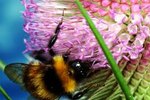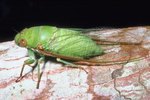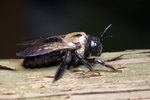
Several species of wasps burrow in the ground to build their nests, leaving mounds of dirt piled above the ground. With the exception of yellowjackets, which are social wasps who form colonies, most burrowing wasps are solitary. Burrowing wasps except the yellowjacket, are non-aggressive and mostly harmless to humans. This ground-nesting species also makes a habit of burying prey and eggs together, sealing them inside to allow the larvae to feed on the prey as they grow.
Cicada Killers
Cicada killers, (Sphecius speciosus) are unusually large wasps that reach about 1.5 inches in length. They have black and yellow markings on the abdomen that sometimes cause them to be mistaken for yellowjackets or bees, despite their large size. Their common name comes from the fact that they prey on cicadas. Female cicada killers dig underground burrows about 1/2 inch wide and up to 10 inches long, with up to 10 side chambers in which they store paralyzed cicadas to feed their young.
Digger Wasps
Sphex ichneumoneus, the great golden digger wasp, is another large solitary wasp that possess a black head and thorax, each of which are covered with short, golden hair, and large, amber-colored wings. The female great golden digs around half a dozen nests during the summer months in preparation for egg laying, using her mandibles and forelegs to dig. These nests have a main tunnel about a1/2-inch wide and 4 to 6 inches deep, with secondary tunnels connecting to individual chambers for storing prey. Another wasp, Scolia dubia, is also referred to as a digger wasp. These are small, slender wasps, about 3/4 inch in length. This digger wasp preys mainly on grubs, and is unusual for capturing her prey before digging an individual chamber for it in the ground, leaving a fist-sized mound of dirt above ground to mark the spot.
Beetle Eaters
Cerceris fumipennis, found throughout the southern United States, feeds mainly on the adult Emerald Ash Borer beetle, although it will also prey on related beetle species such as the metallic woodboring beetle. After paralyzing the beetle with venom from her stinger, the female wasp carries the beetle back to her nest, which is usually bored into dry, sandy ground. Although these are solitary wasps, sometimes multiple females will build their nests close together, giving the impression of a loosely formed wasp colony.
Yellowjackets
Yellowjackets are social wasps that nest in colonies, but they are also very aggressive about defending the nest. The name yellowjacket actually applies to several different species within the genus Vespula, all of which share similar size and coloring with the European honey bee. Because of their aggressive nature and painful stings, yellowjackets are sometimes mistaken for African killer bees. They usually build their large nests in the ground, often using abandoned burrows left by rodents, but sometimes they are aerial nesters, building their nests in rock walls and between the walls of buildings. One nest can hold a colony of thousands of yellowjacket wasps.
References
- UC Riverside Etymology: Pests Attacking Man and His Pets
- East Texas Gardening: What's Bugging You?
- Galveston County Master Gardeners: Beneficials in the Garden: Great Golden Digger Wasp
- Alabama Cooperative Extension System: Digger Wasp
- Nova Scotia Department of Natural Resources: Insectary Notes: C. fumipennis and EAB (PDF)
Photo Credits
-
Hemera Technologies/PhotoObjects.net/Getty Images
Writer Bio
Jean Marie Bauhaus has been writing about a wide range of topics since 2000. Her articles have appeared on a number of popular websites, and she is also the author of two urban fantasy novels. She has a Bachelor of Science in social science from Rogers State University.




